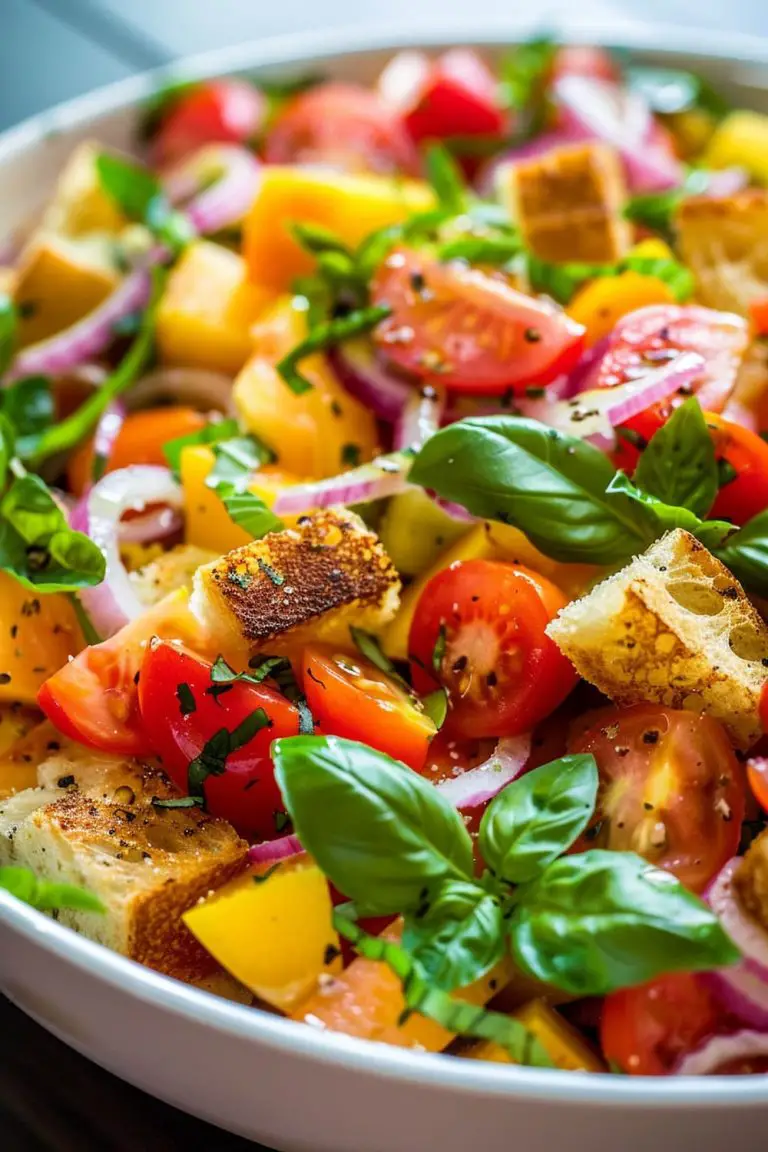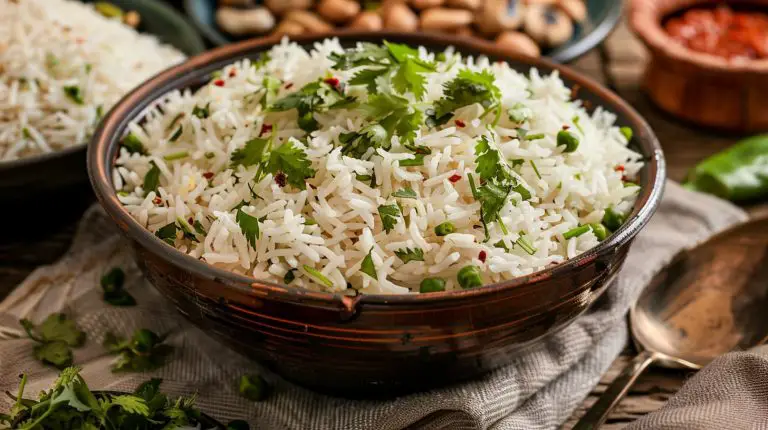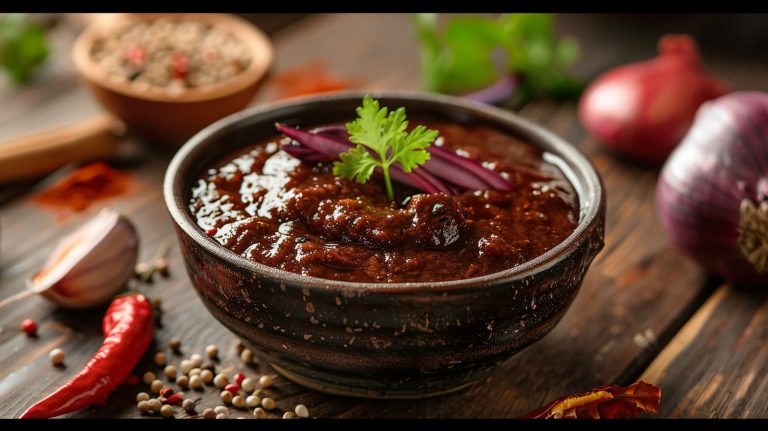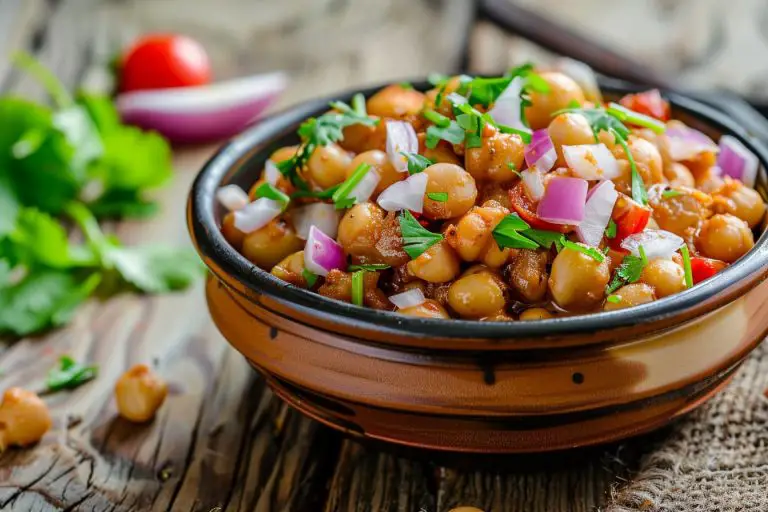Simple Indian Mint Chutney 15 Minute Recipe
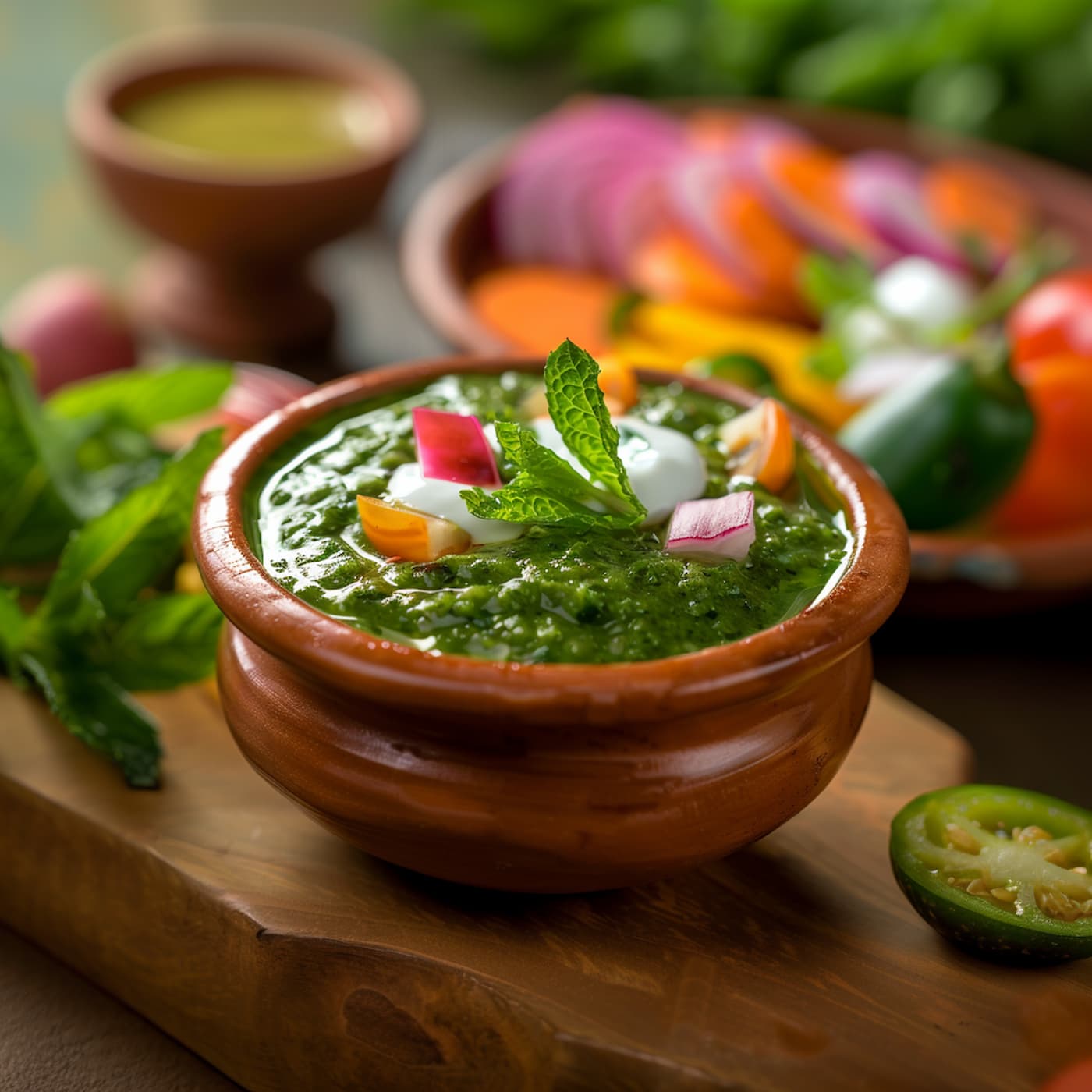
Indian Mint Chutney is a celebrated Indian recipe cherished across the globe for its refreshing and vibrant flavors.
In just 10-15 minutes, with simple, yet flavorful ingredients, you can create an authentic Indian masterpiece right in your kitchen.
In this guide, you’ll learn
- Some Interesting Facts and Origin Story of Mint Chutney
- How to make mouth-watering Mint Chutney in your kitchen
- Healthy Vegan Alternatives For The Items Used In the Recipe
- Common Mistakes To Avoid, Pro Tips To Enhance The Taste Of the Dish
- FAQs (Reader Questions Answered) and much more stuff!
So, grab your apron, and let’s dive in!
Some Interesting Facts About Mint Chutney
- The tradition of chutney in India dates back centuries, with early references found in ancient Sanskrit literature around 500 BC. Initially, chutneys were a means to preserve perishable fruits and vegetables, allowing people to enjoy their flavors year-round.
- The word “chutney” comes from the Hindi word “chatni,” which means to lick, highlighting the addictive quality of these condiments.
- Chutneys were introduced to the Western world through trade and colonization, with the Portuguese bringing them to Europe in the 15th century. This led to the adaptation of chutney recipes to include local ingredients such as tomatoes, apples, and apricots in Europe
India’s vast culinary landscape offers a diverse array of chutneys, with mint chutney being one of the many.
- Each region has its unique take on chutneys, influenced by local ingredients and culinary traditions.
- For example, in South India, coconut-based chutneys are prevalent, while in North India, chutneys featuring mint, coriander, and tamarind are popular.
- The eastern part of the country often includes raw mangoes in their chutneys, whereas the western regions might favor peanut and sesame-based chutneys
While traditionally made with mint, coriander, and basic seasonings, Indian Mint Chutney welcomes variations. You can easily adapt it to include your favorite herbs, nuts for creaminess, or even fruits like mango for a sweet twist, making it a perfect fit for different dietary preferences or meal times.
How to Make Yummy Mint Chutney At Home
Prep Time: 15 minutes
Cooking Time: 0 minutes
Ingredients:
- Mint Leaves: 2 cups, fresh for that distinct Indian flavor.
- Cilantro (Coriander Leaves): 1 cup, adds vibrancy and aroma.
- Green Chilies: 2-3, for a more pronounced heat reflective of Indian palate preferences.
- Ginger: 1-cm piece, adds a sharp, peppery layer.
- Garlic: 1-2 cloves, for a pungent depth.
- Roasted Ground Cumin: 1 teaspoon, for an earthy, smoky undertone.
- Amchur (Dry Mango Powder): ½ teaspoon, introduces a tangy, fruity acidity.
- Chaat Masala: ½ teaspoon, for that quintessential Indian street food flavor. (optional)
- Yogurt: ½ cup, to bring everything together. (Healthy Alternative: Use low-fat or plant-based yogurt for a lighter version. If you don’t want to use yogurt at all use cashews)
- Salt: To taste.
- Sugar: 1 teaspoon, for a traditional sweet balance. (Healthy Alternative: Use a small amount of honey or jaggery.)
- Water: Sparingly, to adjust consistency.
Instructions:
- Prep Your Greens: Start by lovingly washing the mint and cilantro leaves under cold water.
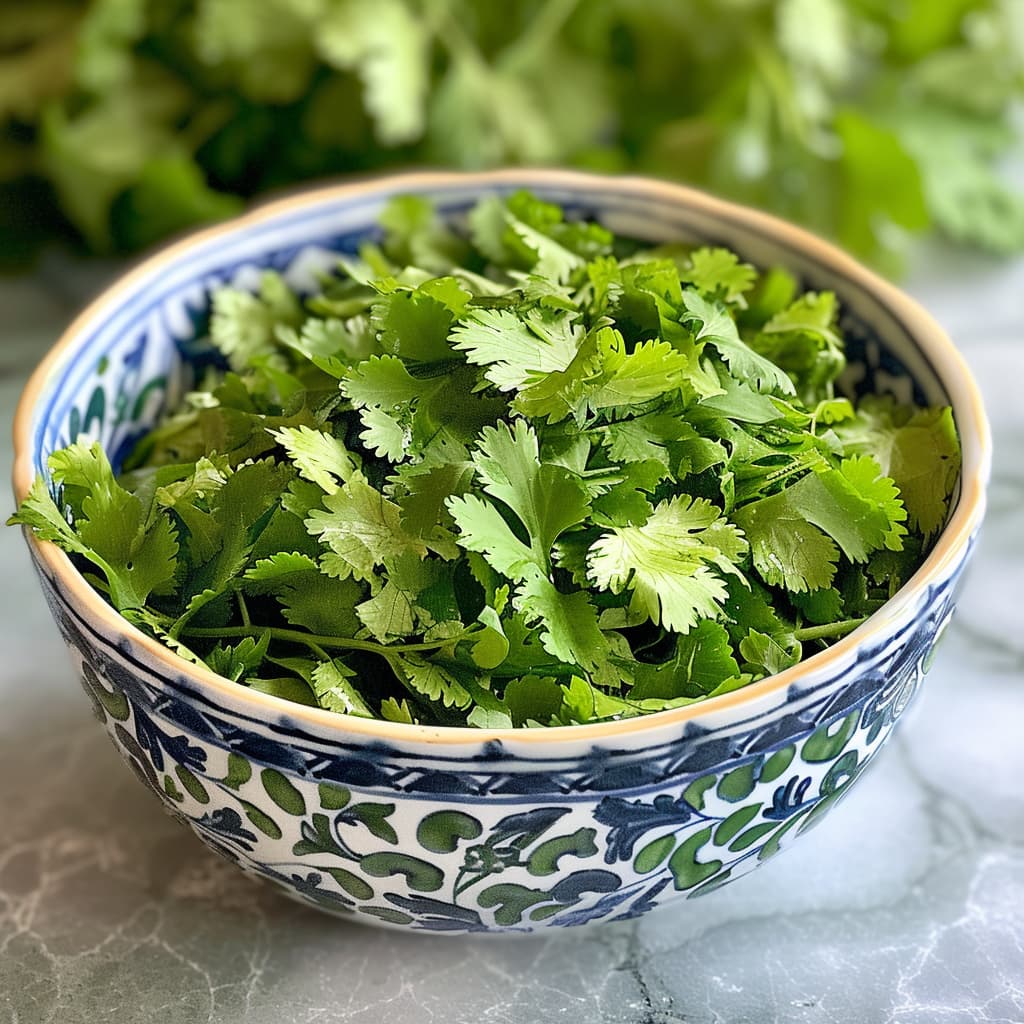
This step is crucial, as it ensures your chutney is not just flavorful but also clean and hygienic. Roughly chop the ginger and garlic for easier blending.
- Roast and Grind Cumin: If not using pre-roasted cumin, lightly roast the cumin seeds. Heat a small pan over low heat and dry-toast the cumin seeds until they’re aromatic.
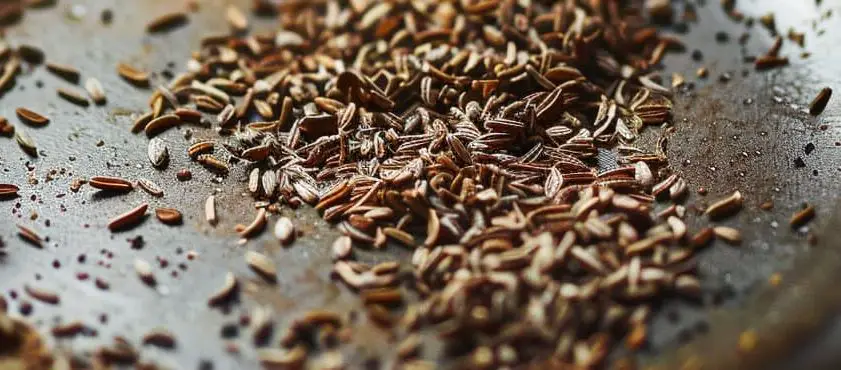
It only takes a minute, but it’s a minute that infuses your chutney with a warm, earthy undertone, then grind them into a powder. This enhances the chutney with a warm, nutty flavor.
- Blend the Greens and cumin seeds: In a grinder, combine the mint, cumin, cilantro, green chilies, ginger, and garlic. These fresh ingredients form the vibrant base of your chutney.
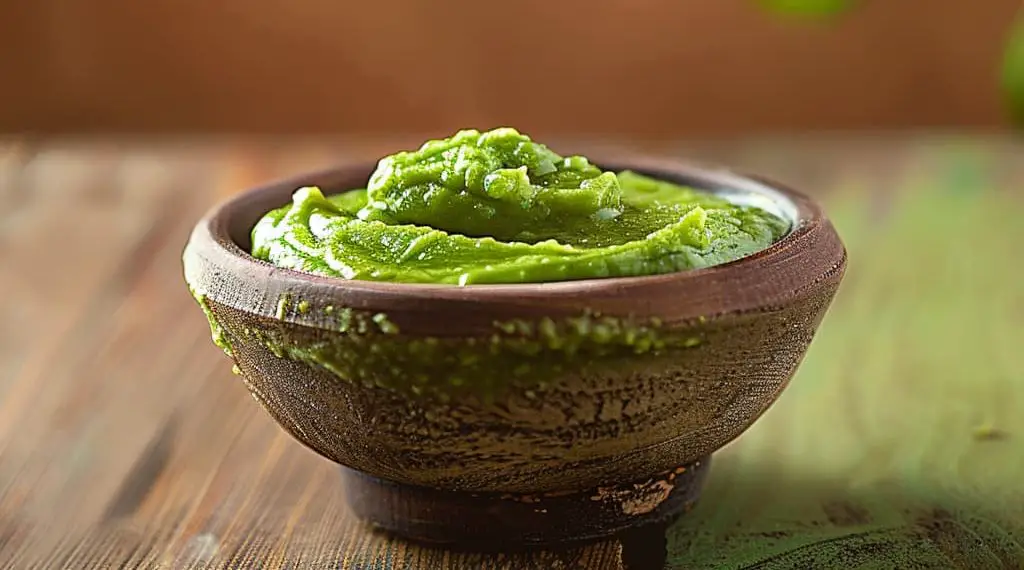
The chilies add a kick, while the cumin brings a smoky depth. Pulse until the ingredients are roughly combined. As for the chilis, if you’re sensitive to heat, start with half a chili and adjust upwards for taste. Remember, it’s easier to add heat than to subtract it.
- Incorporate Flavors: Add the roasted ground cumin, amchur, chaat masala, and a pinch of salt to the blender. The amchur and chaat masala are key to achieving that authentic Indian chutney taste, adding layers of tanginess and spice. In case you don’t have amchur powder available, you can use lemon juice for this.
- Add Creaminess and Sweetness: Blend in the yogurt and sugar.
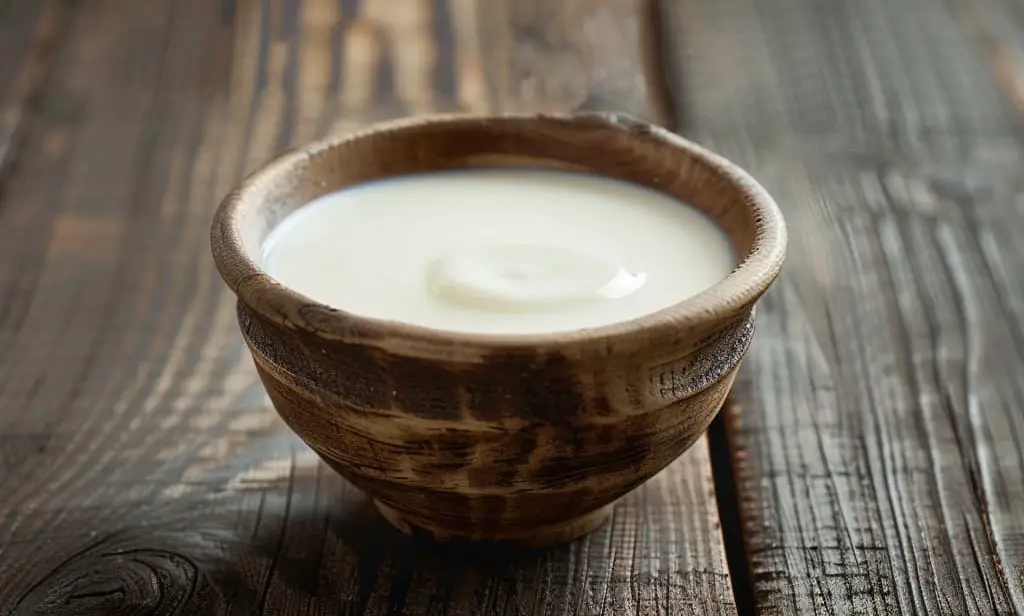
The yogurt smooths out the chutney, while sugar adds a rich sweetness. Choosing between full-fat and low-fat or dairy-free yogurt can significantly change the texture and health profile of your chutney. So that’s a personal call.
- Adjust Consistency and Taste: Now, blend everything until smooth, adding a little water if necessary to get the right consistency. You’re looking for a consistency that’s easily spoonable but not watery. Taste and adjust the seasoning, maybe a pinch more salt, a squeeze of lemon, or another teaspoon of sugar.
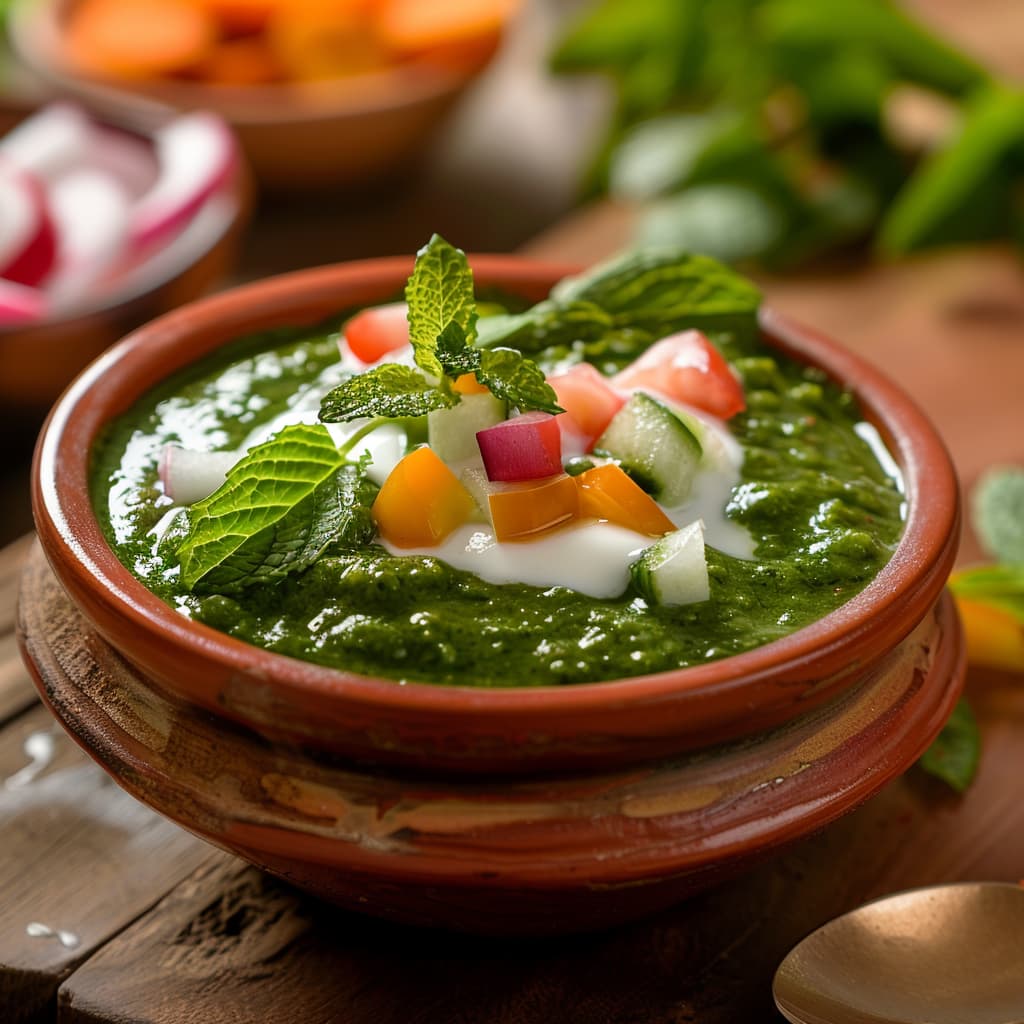
- Serve with an Indian Touch: Your mint chutney is ready to be served,. Garnish it with carrots, onion rings or lemon. It pairs wonderfully with grilled vegetables, as a dip for savory snacks like samosas, and pakoras, or as a spread in wraps and sandwiches.
Healthy Alternatives For The Ingredients Used In the Mint Chutney Recipe
- Yogurt: Use a plant-based yogurt, such as almond, coconut, soy, or cashew yogurt, to keep the creaminess without dairy. Another option is to blend soaked cashews with water to make a creamy base.
- Sugar: Substitute with a small amount of maple syrup, jaggery, agave nectar, or date syrup for a natural and vegan sweetener. These alternatives offer a healthier profile with lower glycemic indices compared to traditional sugar.
Mistakes To Avoid
Ingredient Selection
Common Errors:
- Using Dried Herbs: Freshness is key for mint chutney. Using dried mint instead of fresh leaves can significantly diminish the vibrancy and flavor.
- Wrong Type of Mint: There are many varieties of mint, but for chutney, spearmint is often preferred for its balance between sweetness and menthol.
- Ignoring Quality: Compromising on the freshness and quality of ingredients like garlic, ginger, and green chilies can affect the overall taste.
How to Avoid:
- Always opt for fresh mint leaves. Look for bright, vibrant leaves without any dark spots or signs of wilting.
- Select fresh, high-quality ingredients for all components of the chutney. Freshness in ingredients like lemon (for lemon juice) and cilantro (if using) is crucial.
Preparation Pitfalls
Common Errors:
- Over-blending: Blending for too long can make the chutney too liquidy and may also turn it bitter due to the over-processing of the mint leaves.
- Improper Washing: Mint leaves can harbor dirt and need to be washed thoroughly.
How to Avoid:
- Pulse the ingredients in short bursts and check consistency frequently to achieve the desired texture.
- Wash the mint leaves in a bowl of water, swishing around to loosen any dirt, and then rinse under running water.
Cooking Techniques
Mint chutney is usually not cooked, but here’s a related mistake:
- Heating the Chutney: Some might attempt to heat the chutney to blend flavors, which can cause it to lose its vibrant color and fresh flavor.
How to Avoid:
- Mint chutney is best enjoyed fresh. Avoid any heating process to maintain its bright green color and refreshing taste.
Seasoning and Flavoring
Common Errors:
- Over or Under Seasoning: Adding too much salt or not enough can significantly affect the chutney’s flavor balance.
- Ignoring Acidity: Not adjusting the acidity properly can result in a flat-tasting chutney.
How to Avoid:
- Start with a smaller amount of salt, taste, and then adjust accordingly.
- Use fresh lemon juice to adjust acidity. Start with a little, taste, and then add more as needed to achieve a bright, balanced flavor.
Presentation Tips
Common Errors:
- Ignoring Color: The vibrant green color is a big part of the appeal of mint chutney. Over-blending or not using fresh ingredients can result in a dull color.
- Improper Serving: Serving in a way that doesn’t showcase the chutney’s texture and color can detract from its appeal.
How to Avoid:
- To maintain the vibrant green color, blend the chutney just until it reaches the desired consistency. Adding a bit of ice while blending can also help preserve the color.
- Serve the chutney in a clear or white dish to highlight its color. A garnish of fresh mint leaves can add to its visual appeal.
Pairing Suggestions for Mint Chutney
Side Dishes:
- Samosas or Pakoras: The spiciness of mint chutney cuts through the richness of fried foods, enhancing their flavors.
- Grilled Vegetables: Mint chutney can act as a fresh, herbal sauce that adds depth to the smoky flavors of grilled veggies.
Main Courses:
- Tandoori Chicken or Fish: The robust flavors of tandoori dishes are balanced by the cool, tangy profile of mint chutney.
- Lamb Kebabs: The gamey flavor of lamb pairs exceptionally well with the bright, herby notes of the chutney.
Seasonal Variation for Mint Chutney
Spring/Summer:
- Incorporate more citrus fruits like lime or orange to add a refreshing zest, perfect for warmer weather.
- Add cucumber to the chutney for a cooling effect and a lighter consistency, making it an ideal accompaniment for grilled dishes.
Fall/Winter:
- Introduce roasted nuts (e.g., almonds or walnuts) to the recipe for a deeper flavor and added texture, complementing the hearty meals of colder months.
- Mix in dried fruits (such as raisins or apricots) for a subtle sweetness and a hint of warmth, pairing well with winter dishes.
All Year Round:
- Adjust the heat by varying the amount of green chilies according to taste and seasonal preference. Less in summer to keep it cooler, and more in winter for a warming effect.
- Experiment with herbs besides mint, such as cilantro in spring or parsley in fall, to align the chutney’s flavor with the available seasonal produce.
Always Keep In Mind that the inclusion of newer veggies or spices can impact the dish’s overall taste, so you may need to adjust your other spices or salt portions to counter that.
Common Problems You May Face While Cooking Mint Chutney
Problem 1: Getting the Right Consistency
Your Concern: The chutney is too watery or too thick.
Solution: Finding the perfect consistency is all about balance. If your chutney is too thick, add a little water or lemon juice to thin it out. On the flip side, if it’s too watery, add more mint leaves or a small amount of breadcrumbs to thicken it. Remember, it’s easier to add more liquid to thin it down than to correct a chutney that’s become too watery.
Problem 2: Flavor Balance
Your Concern: The chutney tastes too bitter, too sour, or not flavorful enough.
Solution: Mint chutney should have a harmonious balance of tangy, spicy, and fresh flavors. If it’s too bitter, you might have included too many mint stems. Stick to the leaves for a fresher taste. If it’s too sour, balance it out with a pinch of sugar. Not flavorful enough? Add a bit more salt, a squeeze of lemon juice, or a small amount of roasted ground cumin to enhance its taste.
Problem 3: Choosing Mint Leaves
Your Concern: The chutney doesn’t taste as fresh as expected.
Solution: The freshness of your ingredients is key. Always choose vibrant, green mint leaves without any brown spots. Before using them, give the leaves a good wash in cold water to remove any dirt and to revive their freshness.
Problem 4: Grinding the Ingredients
Your Concern: Achieving a smooth blend without a food processor.
Solution: If you don’t have a food processor, a mortar and pestle will work fine, though it requires a bit more effort. Start by grinding the chilies and garlic into a paste before adding the mint leaves. Grinding in batches can also make the process easier and ensure a smoother consistency.
Problem 5: Storing for Later Use
Your Concern: The chutney loses its vibrant green color and freshness when stored.
Solution: Oxidation can cause the chutney to darken, but this can be minimized. Add a touch of oil on top before sealing it in an airtight container, and store it in the refrigerator. To maintain its vibrant color, you can also add a bit of acidic content, like lemon juice, which helps preserve the green color. For longer storage, freeze it in ice cube trays and thaw as needed.
Tips for Perfecting Mint Chutney
- Select Fresh Ingredients: The quality of mint chutney largely depends on the freshness of the mint leaves and cilantro. Opt for bright, vibrant leaves without any signs of wilting or browning. Freshness contributes to the chutney’s vivid color and intense flavor.
- Balance the Flavors: Achieving the right balance between tangy, spicy, sweet, and savory elements is crucial. Use fresh lime or lemon juice for acidity, adjust green chilies for heat, and consider a hint of sugar to round off the flavors. The addition of roasted ground cumin can add a depth of flavor that’s authentically Indian.
- Use Ice Water When Blending: To maintain the green color and prevent the chutney from heating up during blending, use a little ice water. This helps in keeping the chutney vibrant and fresh-looking.
- Texture Matters: The texture of the chutney can greatly affect its taste and application. For a smoother chutney, blend thoroughly. For more texture, pulse blend to your desired consistency. This can make the chutney more versatile, and suitable for different dishes.
- Presentation: Serve the chutney in a way that enhances its appeal. Consider using a dark or contrasting colored bowl to make the vibrant green color pop. Garnishing with a sprig of fresh mint can also add to its visual appeal.
FAQs about Mint Chutney (Reader Questions Answered)
Q1: Can I use dried mint instead of fresh mint leaves?
- Solution: Fresh mint leaves are preferred for their vibrant flavor and color, which dried mint cannot match. However, if fresh mint is not available, you can use dried mint as a last resort.
Remember, the flavor will be less pronounced, so you may need to adjust the quantity. Use about 1/3 of the amount of dried mint as a substitute for fresh mint.
Q2: What can I do if the chutney is too spicy for my taste?
- Solution: If the chutney turns out too spicy, you can tone down the heat by adding more yogurt (if the recipe allows) or a bit of cream. Adding a sweetener, like sugar or honey, can also balance out the spiciness.
Q3: How long can I store mint chutney, and how should I store it?
- Solution: Mint chutney can be stored in an airtight container in the refrigerator for up to a week.
Q4: The mint chutney turned brown after a day. How can I prevent this?
- Solution: Browning is typically due to oxidation. To prevent this, add a little lemon juice to the chutney before storing it, as the vitamin C acts as an antioxidant. Also, ensure the chutney is stored in an airtight container and topped with a thin layer of oil to minimize exposure to air.
Q6: Can I make mint chutney without garlic?
- Solution: Yes, you can omit garlic if you prefer or are allergic to it. The chutney will still taste great, though it will have a milder flavor. You can add a bit more ginger or a dash of ground cumin to compensate for the flavor depth that garlic provides.
Q7: How do I make my mint chutney creamier?
- Solution: To achieve a creamier texture, you can add more yogurt or a small amount of nuts like cashews or almonds to the chutney before blending. These ingredients add richness and creaminess to the texture.
Q8: Can mint chutney be used as a marinade?
- Solution: Absolutely! Mint chutney makes an excellent marinade for meats, tofu, or vegetables. Its acidity and aromatic herbs tenderize the protein while infusing it with flavor. Just coat your chosen ingredient with the chutney and let it marinate for a few hours before cooking.
Q9: What are some good substitutes for mint in this chutney?
- Solution: While mint is a key ingredient, you can adjust the flavor profile by using more cilantro if mint is unavailable. A small amount of basil can also complement the chutney’s flavor, though the taste will differ.
Q10: My chutney is too watery; how can I thicken it?
- Solution: If your chutney is too thin, add more mint leaves or cilantro to thicken it. You can also incorporate a small amount of ground nuts like cashews or almonds, which will add body and richness.
Q5: Is there a way to reduce the bitterness of the chutney?
- Solution: Bitterness can sometimes result from over-blending the chutney, which can make the leaves bitter, or from using stems. To reduce bitterness, focus on using the leaves more than the stems, and add a bit of sweetness with sugar or honey to balance the flavors.
So thats it…If you have any queries leave a comment below.
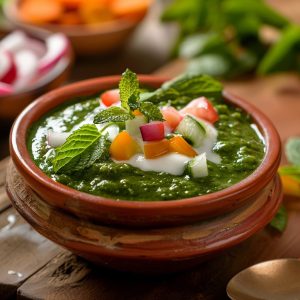
Simple Indian Mint Chutney 15 Minute Recipe
Ingredients
- Mint Leaves: 2 cups fresh for that distinct Indian flavor.
- Cilantro Coriander Leaves: 1 cup, adds vibrancy and aroma.
- Green Chilies: 2-3 for a more pronounced heat reflective of Indian palate preferences.
- Ginger: 1-cm piece adds a sharp, peppery layer.
- Garlic: 1-2 cloves for a pungent depth.
- Roasted Ground Cumin: 1 teaspoon for an earthy, smoky undertone.
- Amchur Dry Mango Powder: ½ teaspoon, introduces a tangy, fruity acidity.
- Chaat Masala: ½ teaspoon for that quintessential Indian street food flavor. (optional)
- Yogurt: ½ cup to bring everything together. (Healthy Alternative: Use low-fat or plant-based yogurt for a lighter version. If you don’t want to use yogurt at all use cashews)
- Salt: To taste.
- Sugar: 1 teaspoon for a traditional sweet balance. (Healthy Alternative: Use a small amount of honey or jaggery.)
- Water: Sparingly to adjust consistency.
Instructions
Prep Your Greens:
- Start by lovingly washing the mint and cilantro leaves under cold water.
- This step is crucial, as it ensures your chutney is not just flavorful but also clean and hygienic. Roughly chop the ginger and garlic for easier blending.
Roast and Grind Cumin:
- If not using pre-roasted cumin, lightly roast the cumin seeds. Heat a small pan over low heat and dry-toast the cumin seeds until they're aromatic.
- It only takes a minute, but it’s a minute that infuses your chutney with a warm, earthy undertone, then grind them into a powder. This enhances the chutney with a warm, nutty flavor.
Blend the Greens and cumin seeds:
- In a grinder, combine the mint, cumin, cilantro, green chilies, ginger, and garlic. These fresh ingredients form the vibrant base of your chutney.
- The chilies add a kick, while the cumin brings a smoky depth. Pulse until the ingredients are roughly combined. As for the chilis, if you're sensitive to heat, start with half a chili and adjust upwards for taste. Remember, it's easier to add heat than to subtract it.
Incorporate Flavors:
- Add the roasted ground cumin, amchur, chaat masala, and a pinch of salt to the blender. The amchur and chaat masala are key to achieving that authentic Indian chutney taste, adding layers of tanginess and spice. In case you don’t have amchur powder available, you can use lemon juice for this.
- Add Creaminess and Sweetness: Blend in the yogurt and sugar.
- The yogurt smooths out the chutney, while sugar adds a rich sweetness. Choosing between full-fat and low-fat or dairy-free yogurt can significantly change the texture and health profile of your chutney. So that’s a personal call.
Adjust Consistency and Taste:
- Now, blend everything until smooth, adding a little water if necessary to get the right consistency. You’re looking for a consistency that’s easily spoonable but not watery. Taste and adjust the seasoning, maybe a pinch more salt, a squeeze of lemon, or another teaspoon of sugar.
Serve with an Indian Touch:
- Your mint chutney is ready to be served,. Garnish it with carrots, onion rings or lemon. It pairs wonderfully with grilled vegetables, as a dip for savory snacks like samosas, and pakoras, or as a spread in wraps and sandwiches.


